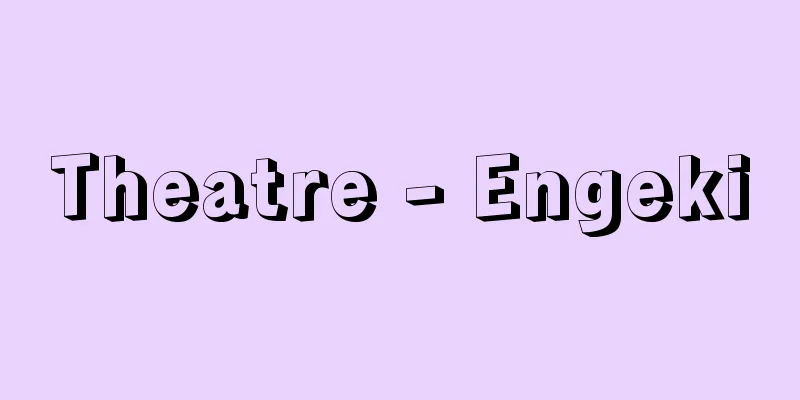Theatre - Engeki

|
It is a form of art expressed through words and gestures, and is also a cultural style that is always and everywhere present in human society. In Japan, the word "theater" was used after the Meiji period, and before that it was called "shibai" (play). This is because the Ennen Dance, which flourished from the Heian period to the Middle Ages, was performed while sitting on the grass in a temple garden. The character "geki" (drama) was not even used, and at the time "xi" (play) was used following the Chinese example, and theaters were called "geijo" (play hall). In the West, the term theater is used in English, théâtre in French, and Theater in German, which also originated from theatron, which meant "a place to watch" in ancient Greek drama. The origins of these words imply the importance of the audience as the essence of theater. [Toshio Kawatake] The Essence of TheatreIn Greece, the five arts were poetry, music, painting, sculpture, and architecture, and there was no genre called drama. Greek drama was the recitation of poetry, and tragedy and comedy were considered to be in the field of poetry along with epic poetry. Dance, followed by drama, was established as a unique artistic style using the human body as its expressive material only in modern times, and in that sense it is the seventh art, but since it contains elements of all five arts it is also called a "comprehensive art." Drama is the same as dance in that it uses the body as its medium, but dance does not necessarily have to have a dramatic plot. However, when it comes to drama, no matter how short it is, it must have a series of dramatic plot developments with a human theme, that is, "dramatic actions." The character "drama" is a combination of "tiger" (tora), "boar" (inoshishi), and "katana" (katana), which refers to a bladed weapon, and refers to the fighting between two fierce opponents. A dramatic act is a process in which the contradictions and conflicts between humans and something else, such as between humans and fate, God, circumstances, social evils, or other humans or the conflicting natures hidden within humans themselves, gradually come to the surface and fight violently, producing one action after another and leading to a conclusion. And the prototype of this is the stage script, the drama. They do not necessarily have to be written down, but as they develop from primitive, improvisational theatrical performances to advanced theatrical performances and are established in writing, dramas also become a type of literature. As a developed element of theatre, a play is written primarily around dialogue, with the actors acting as if it were a current event occurring before the viewer's eyes, supplemented by the introduction and removal of characters, and the setting of scenes, situations, and actions, but this differs from other literary forms in that the play is written primarily around dialogue. [Toshio Kawatake] The three elements of theatreActors, the play (dramatic action), and the audience are said to be the three elements of theater. Of course, a theater is necessary as a venue for theatrical performances, so adding this makes four elements, but we must not forget the role that the audience plays in theater. If the performance is good, the audience expresses their excitement, and if it is bad, they express dissatisfaction. The vibrations of their reactions immediately reach the stage and affect the outcome of the play. In other words, the audience is not simply a spectator, but actively and simultaneously participates in the creation of theater. This direct exchange and empathy is due to the fact that actors and audience are fundamentally one, and this is a major difference between theater and other arts, and also a fundamental difference between theater and other arts such as film and television, which are reproduced by machines. [Toshio Kawatake] The origins and development of theatreTheater is thought to have developed from simple dance or mimicry of gestures, but its origins date back to ancient times when humans began to live in society, and its deep connection with religious ceremonies cannot be overlooked. This can be seen in Greek theater, which arose from a waltz chorus that gave thanks to Dionysus, the god of grapes and wine, and praised his virtues; in the Iwato-no-mai of Ame-no-Uzume-no-Mikoto, a sun-worshiping devotional dance that is said to be the ancestor of Japanese Kagura; in folk performing arts that remain in various places; and in the primitive theater of uncivilized peoples. When people prayed for the improvement and security of production, the elimination or overcoming of death, disease, and natural threats, victory in battle, and the fulfillment of love, when they were thankful for daily peace and stability, and when they sought a better life, it was a powerful method for singers and dancers to become one and lose themselves, to invite and assimilate with the gods as supernatural forces. This is called the principle of sympathetic magic. So-called shamanism is a typical example, but within this state of unconscious drama, which was a serious endeavor, lurked the fundamental experiences of theater. Gradually, it was divided into those who watched and those who watched, and epic poems and war literature provided a wealth of content, leading to the birth of professional playwrights and the development of theaters. In particular, as we approached the modern era, auxiliary elements such as stage equipment and lighting also differentiated and developed, and a position to unify them was required. That job is directing, and the person who performs it is the director. As mentioned above, theater is said to be a comprehensive art, but it is not simply a combination of various elements; it must be a unique artistic world that is born from the harmonious fusion and fusion of many elements through excellent direction. [Toshio Kawatake] The development of Western theatreAncient drama, which is the origin of Western theater, was perfected in Greece in the 5th century BC. Originating from a choral waltz praising the god Dionysus, it became a national festival event held in large outdoor theaters as city-states (polis) were established. Eventually, the content moved away from the life story of Dionysus to incorporate myths and heroic legends, the number of actors increased from one to two or three, and the theatrical form was established, reaching its peak in the Periclean era in the 5th century BC, centered around Athens. The spring rites gave birth to solemn tragedies (tragoidea), which produced writers such as Aeschylus, Sophocles, and Euripides, while the winter country festivals gave birth to humorous satirical comedies (comoidia), which produced Aristophanes. Aristotle's "Poetics," written slightly later, is an excellent work that analyzes and meticulously discusses the great works of tragedy, and it still occupies an important position as the origin of Western drama theory. In particular, his definition of tragedy is famous: a complete act in itself, that is, an imitation of a solemn act with a beginning, middle, and end, which, when performed, provokes fear and sympathy, and brings about emotional catharsis. Roman theatre, which inherited from Greece, was more animalistic and earthly, favoring spectacle, and rather than making use of the tradition of tragedy, it moved toward vulgar comedy and improvised pantomime, boasting the decoration of lavish large open-air theatres. Therefore, the works of dramatic poets who followed the Greek theatre (Seneca, Terence, Plautus, etc.) were only recited among aristocrats and scholars, and did not become popular among the masses, and in terms of quality they did not go beyond imitating the Greeks. Horace's "De Poetics" is a theatrical treatise, but in contrast to the analytical and aesthetic theoretical system of Aristotle's "Poetics," it is mainly about practical techniques. In the Middle Ages, as was the general trend during the so-called Dark Ages, the traditions of ancient theatre disappeared from the surface, and religious plays performed in churches by monks to spread Christianity became dominant. At first, these were in Latin, but gradually they became more and more varied in each country, and common people began to participate. Meanwhile, with the development of guilds, folk theatre (secular theatre) flourished and began to form the basis of modern theatre. For example, vulgar but professional professional theatre, which descended from the Roman mimos, eventually became the Italian Commedia dell'arte, which had a significant influence on Molière and others. However, there is nothing worth looking at in terms of theatre theory from this period. With the advent of the Renaissance, the study of ancient times progressed in Italy in the 16th century, starting with the translation of Aristotle's Poetics. Stage equipment using perspective was invented, and indoor theaters developed. Teatro Olimpico and Teatro Farnese were built, and the foundations of early modern and modern theaters with framed stages were established. In the 17th century, the tradition of ancient theater was revived in France, ushering in the heyday of classical theater under the reign of Louis XIV, producing tragedies by Corneille and Racine, and comedies by Molière. All of these were characterized by rational and harmonious structure, and the so-called triple unity (triple unity), which aims for unity of plot, time, and place, was an ironclad rule. This idea gradually took shape in Italy, and against the backdrop of 17th century French court culture, was perfected by the ideals of rationality, harmony, and order, and its apex was Boileau's Poetics. In the 16th and 17th centuries in Western Europe, other writers such as Lope de Vega and Calderon de la Barca appeared in Spain and wrote free-spirited plays, while in England Shakespeare depicted human beings vividly by weaving lively poetry and rhetoric into his free dramaturgy, and Elizabethan drama blossomed. However, classicism was dominant at the time, and Shakespeare's genius was not highly evaluated. However, in the second half of the 18th century, Lessing appeared in Germany and criticized the stagnation of classicism in his Hamburg Drama, while he praised Shakespeare for the revival of the classics and the correct performance of the classics. Goethe and Schiller followed, leading the German Romanticism, and Diderot in France also advocated the idea of citizen theater, encouraging a movement toward modern drama. In general, early modern theater saw the rise of professional actor troupes, the increase in multi-act performances in indoor theaters, and the dramatic content gradually became unique to each country, developing into what could be called national drama, with plays beginning to portray ordinary people instead of gods and heroes. After the romantic theater of the early 19th century, modern naturalistic theater emerged in the latter half of the 19th century with the proposal of evolutionary theory and the development of natural sciences such as physics and astronomy, as well as mechanical technology. Authors such as Ibsen, Strindberg, Hauptmann, and Chekhov appeared, and the strongholds of the modern realistic theater movement included Antoine's Free Theater, Grain's Independent Theater, Brahm's Free Stage, and Nemirovich-Danchenko and Stanislavski's Moscow Art Theater. It was during this period that theater moved away from actor-centered commercial theater, placing the exploration of life as its primary objective, and the job of directing was emphasized and established, seeking respect for the content of the work and harmonious, total expression. Of course, one of the reasons for this was the need to unify the various elements of equipment, lighting, and other technological developments. However, in the 20th century, a trend towards anti-naturalism that went beyond this and tried to directly approach the inner essence of human beings appeared, which rapidly became active around the time of World War I, and various styles such as symbolism, expressionism, and constructivism were attempted. In addition, ideological and revolutionary theatrical activities that considered themselves as one of the social functions, such as the proletarian theater movement, also became popular, and these had a great influence on the new theater movement in Japan. The theatrical challenge today is how to overcome Ibsen's modern classical drama, and various manifestations of this can be seen in Brecht's epic theater in Germany, verse drama in England and France, modern French anti-theatre, physicalist theater that has spread to other countries, and the avant-garde small theater movement with audience participation. In addition to modern theater after O'Neill, in the United States, a unique style of musical was created and has been steadily growing, and has been incorporated into contemporary theater in other countries. [Toshio Kawatake] Oriental TheatreIn the East, too, theater is thought to have originated from ritual performing arts based on ancient primitive beliefs, but the history and styles of its development vary greatly from country to country. Western theater has a common foundation in Christian culture due to its existence in the Middle Ages, and developed through close mutual influence in terms of drama and style. In contrast, while Eastern theater has similarities, it is difficult to prove a particularly close correlation in terms of its development history. Furthermore, many of them remain at the primitive or folk performing arts stage, and each style coexists, so compared to the West, the development of drama and dramatic literature is sparse, with song and dance being the main focus, and its development can only be understood as a history of performing arts styles. For example, the shadow puppet theater called Wayang in Java, court dance, Balinese dance, devil mask dance in Sri Lanka, jumping ghost dance and shaman arts in Korea, Northeast China and Mongolia are all performing arts that reflect the local climate and lifestyle, and have their own unique high artistic and aesthetic value, but they cannot be said to have developed as dramatic compositions. In the East, Japan, China and India have a history of drama and acting direction comparable to that of the West, followed by Korea. The origins of Chinese theater are unclear, but in addition to the native singing and dancing acrobatics, exotic singing and dancing music was imported from the Western Regions during the Six Dynasties period, adding variety to the culture. During the Tang Dynasty (7th century onwards), teaching chambers and pear gardens were established in the imperial court, and singing and dancing improved artistically (Japanese gagaku and bugaku are of this lineage). Furthermore, during the Northern Song and Jin dynasties (10th century onwards), dramatic structures became more complex and the roles of actors were established, and it can be said that the Western concept of theater was basically established at this point. In the Northern Song, this was called Zatugeki, and in the Jin, it was called Inpon. Then, by the Yuan Dynasty (13th century onwards), theater was perfected as Yuanqu (Beikqu). This is a musical drama in four parts (four acts) with songs and dialogue. At the end of the Yuan dynasty, a freer style called Nanqu Nanxi emerged, and in the Ming dynasty, it was called Kunqu and flourished even more. Today's Peking Opera originated in Beijing at the end of the Qing dynasty, and it overwhelmed the previous Kunqu and other styles, becoming one of the two major classical dramas today along with the southern Yue Opera. Since the 20th century, talking dramas have been created based on the Japanese Shinpa and New Drama models, and since the establishment of the People's Republic of China, they have continued to be improved and created under state control. The original style of Indian theatre is also unclear, but it began to develop around the 3rd century, and India's greatest dramatist Kalidasa appeared in the 5th century, bringing about a golden age for the next 400 years. He left behind works such as Shakuntala, based on the ancient epic poem Mahabharata, as well as seven or five-act works with grandiose concepts and full of poetic emotion, and is said to have influenced the German literary giant Goethe. However, theatre only developed up to around the 8th century, and there has been nothing worth seeing since then, and even today, modern drama has not been produced beyond these traditions. In Japan, it originated as folk performing arts associated with religious rites in the mythological era, and after the 7th century, it went through a period of importing and assimilating music and dance from the continent, and developed in a unique way with the establishment of gagaku in the Heian period, Noh and Kyogen in the Middle Ages, and Bunraku and Kabuki in the early modern period. In the modern era, Japan was quick to import Western literature and theater, giving birth to the Shinpa and Shingeki movements, and has played a pioneering role in the East when it comes to modern theatrical arts. Another characteristic of Eastern theater is the unique development of masked dramas, puppet shows, and shadow puppet shows. [Toshio Kawatake] Types of theatreLooking across the world and throughout history, there have been a great many different types of theatre, and there are no uniform classifications for them. For example, by era, there are ancient drama, medieval drama, early modern drama, modern drama, etc., and by means of expression, there are dialogue drama (a normal drama with dialogue and gestures), silent drama (pantomime), dance drama, musical drama, puppet show, etc. The usual classification of plays into tragedy, comedy, resolution drama, farce (farce), melodrama, etc. is based on the dramatic mood or outcome of the action, but there are also an almost infinite number of classifications according to the differentiation and development of theatre, such as by literary form (verse drama, prose drama), by expressive technique (realistic drama, verse drama, expressionist drama, symbolist drama), by dramatic motive (fate drama, situation drama, character drama), by subject matter (historical drama, mythological and legendary drama, social drama, family drama, folk tale drama), by purpose (political drama, religious drama, educational drama, entertainment drama, festival drama, entertainment drama, public drama), by form (chamber drama, outdoor drama, amphitheater), etc. Of course, it is also possible to classify by country, such as Greek drama, British drama, American drama, or to broadly divide Japan into national drama and Western drama. And from the most macroscopic point of view, it is the so-called Western drama that has occupied the mainstream of world theatre. Western theater can be seen as being shaped by the history of conflict between two major trends: classical theater, which began in Greece and led to French classical drama and Ibsen, and non-classical theater, which began in the Middle Ages and passed through Shakespeare, Goethe, and Schiller to present-day anti-naturalism. [Toshio Kawatake] The Function of TheatreAs mentioned above, theater did not arise simply for entertainment or appreciation, but as an indispensable part of life. In other words, it was an unconscious act of humans trying to somehow overcome or dispel anxiety and confirm their own lives when they faced crises in life such as production, illness, death, war, natural disasters, etc. This is still evident today among uncivilized peoples who live primitive lives. And it goes without saying that imitation and playfulness are important elements of theatrical acts. Imitation is a concept established by Aristotle. His teacher Plato rejected theater, literature, and other visual arts as being far from the truth and corrupt because they are merely imitations of reality and real things, which are imitations of ideas, that is, ideal beings (true existences). Aristotle then reinterpreted imitation to establish his theory of affirmation of theater. In other words, humans have an instinct to imitate from the time they are babies, and at the same time, they have a nature that makes them happy when they see something that has been imitated. Imitation is thus essential to life, and theater is nothing other than something that is linked to this instinct. He argued that imitation in theater is not the facts themselves, but the depiction of what life is like in reality, the way it should be. This theory of imitation and the theory of catharsis mentioned above are important views that capture the essence of the function of theater. In this way, humans deliberately create a fictional world, play in it, experience a higher, different dimension of life, and it is there that they truly feel the meaning and joy of human life. In that sense, we can say that theatre is a true reflection of life. The line in Hamlet, "The play is a mirror that reflects life," the Latin phrase, "All the world is a theater," and the Chinese expression, "All the heavens and the heavens are a theater" all show this essence. Excellent theater, therefore, purifies the hearts of its audience in enjoyment and elevates them to the truth and ideals of life. Zeami, the master of Noh, described this as, "The arts, in the first place, are meant to ease people's hearts and to ease their sense of superiority and inferiority. They are the basis for longevity and happiness, and a method for extending one's life." However, because the actors' bodies are so similar to real life, and because the plays appeal to the senses, the degree of empathy and intoxication is so strong that the boundary between reality and fiction can be lost. In Japan, there was a case where a young samurai slashed at a kabuki villain and killed a man who tried to stop him, and in the United States, a soldier shot and killed an actor playing the villain Iago in Othello. In addition, because it has a strong effect on group psychology, it is also useful in political movements and education, and there is a risk that it will lead to corruption and danger. Plato's concerns are true, and the fact that kabuki was cracked down on by the Tokugawa Shogunate as a bad place on par with brothels, and actors and writers were placed in a low position as kawaramono, and that the new drama movement was suppressed as a revolutionary movement from the Taisho to the early Showa periods, all of which support the great social influence of theater. It is only in relatively recent times that theater, both in the East and the West, has been evaluated in terms of its relationship to essential life and positioned positively as an art. In Japan, the importance of theater has been emphasized since the Meiji era by such pioneers as Shoyo Tsubouchi and Ogai Mori, but it was only after World War II that it was recognized by the general public. During the war, interest in theater spread to the provinces due to visits to the military and workers, which helped to popularize and develop regional theater, independent theater, theater spectator organizations, school theater, and so on after the war. The term audiovisual education was also coined, and today it is even called the "face of culture" and is playing a major role in international exchange. The mission of theater is especially important today, when the rapid development of science and technology is raising concerns about the mechanization and dehumanization of humans themselves. This is because theater is an art that ultimately returns humans to the "roots of life" and confirms and restores their humanity. [Toshio Kawatake] "An Introduction to Theatre" by Kawatake Toshio (1978, University of Tokyo Press)" ▽ "A History of World Theatre" by R. Piñar, translated by Iwase Takashi (1955, Hakusuisha)" ▽ "A History of Western Theatre" by Sugawara Taro (1974, Engeki Shuppansha)" ▽ "An Outline of Japanese Theatre History" by Kawatake Shigetoshi (1966, Iwanami Shoten)" ▽ "The World Encyclopedia of Theatre Theory" edited by Ando Shinya et al. (1979, Hyoronsha) [References] |Source: Shogakukan Encyclopedia Nipponica About Encyclopedia Nipponica Information | Legend |
|
ことばと身ぶりによって表現される芸術の一形態で、人間社会においてつねに、どこにでも存在する文化の一様式でもある。日本で「演劇」の語が用いられたのは明治以後のことで、それまでは「芝居」であった。平安時代から中世にかけて栄えた延年(えんねん)舞曲が、寺院の庭の芝生に座って見たものだからである。「劇」の文字も使われず、当時は中国に倣って「戯」が用いられ、劇場も「戯場」といわれた。西洋では、英語でtheatre(シアター)、フランス語でthéâtre(テアトル)、ドイツ語でTheater(テアター)などであるが、これも古代ギリシア劇において「見る場所」を意味するtheatron(テアトロン)からおこった。これらの語源には、演劇の本質としての観客の重要性が暗示されている。 [河竹登志夫] 演劇の本質ギリシアでは、詩、音楽、絵画、彫刻、建築を五芸術とし、演劇という分野はなかった。ギリシア劇は詩の朗唱であって、悲劇、喜劇は叙事詩とともに詩の分野とされていたのである。舞踊、ついで演劇が、人間の肉体を表現材料とする独自の芸術様式として成立するのは近代以降で、その意味では第七芸術ということになるが、五芸術のすべての要素を含むので「総合芸術」ともいわれる。演劇は肉体を媒材とする点では舞踊と同じだが、舞踊はかならずしも劇的な筋をもたなくともよい。しかし、演劇となると、どんなに短いものでも人間をテーマとする一連の劇的な筋の展開、すなわち「劇的な行為(アクション)」が描かれていなくてはならない。「劇」という文字は「虎(とら)」と「豕(いのしし)」と、刃物を示す「刀」の合成で、たけだけしい対立者が相戦うさまを意味している。人間と運命、神、境遇、社会悪、あるいはほかの人間や、人間自体に潜む相反する性情など、つまり人間と他の何物かとの矛盾、対立がしだいに表面化して激しく戦いながら、次々に行為を生んで一つの結末に至る過程、それが劇的行為である。そして、その原型がすなわち上演台本、ドラマ(戯曲)である。それらはかならずしも文字で書かれる必要はないが、原始的、即興的なものから高度な演劇へと発達して文字で定着されるようになるにつれて、戯曲は文学の一種ともなっていく。 発達した演劇の要素としての戯曲は、俳優の行為によって現在眼前で進行しつつある形で、つまり人物の出し入れ、場面、状況、動きの設定などを補足しながらも、あくまで台詞(せりふ)を主体として書かれるところに、他の文学形態との違いがある。 [河竹登志夫] 演劇の三要素俳優と戯曲(劇的行為)と観客を、演劇の三要素という。演劇の場としての劇場はもとより必要だから、これを加えれば四要素となるが、忘れてはならないのは観客が演劇に果たす役割である。観客は、舞台がよければ感動を表明し、悪ければ不満を示す。その反応の波動はただちに舞台に及び、劇の成果を左右する。つまり観客は単なる鑑賞者ではなく、積極的に、また同時的に演劇創造に参加するものだといえる。この直接的な交流共感は、そもそも俳優と観客が根元的には一体であることによるもので、ここが他の芸術との大きな違いでもあり、機械による再生芸術である映画、テレビなどとも本質的に異なる点である。 [河竹登志夫] 演劇の起源とその展開演劇はごく素朴な踊り、あるいは物真似の身ぶり手ぶりから発達したと考えられるが、その起源は人類が社会生活を営み始めた太古にまでさかのぼり、宗教的行事との深い関連を見過ごすことはできない。ブドウと酒の神ディオニソスに感謝して、その徳をたたえる円舞合唱からおこったギリシア劇、日本の神楽(かぐら)の祖とされる太陽崇拝の祈祷(きとう)舞踊としての天鈿女命(あめのうずめのみこと)の岩戸の舞、あるいは各地に残る民俗芸能や、未開民族の原始的演劇にもこのことは認められる。生産の向上と確保、死や病魔や自然の脅威の退散、克服、戦勝や恋愛の成就などを願い、生活不安を除き、日々の安泰を感謝し、さらによりよい生活を求めるとき、歌う者と踊る者が一体となってわれを忘れ、超自然力としての神を招いて同化することは有力な手段であった。それは共感呪術(じゅじゅつ)の原理とよばれる。いわゆるシャーマニズムもその典型例だが、この真剣な営みであった無意識劇の状態のなかに演劇の根元的な原体験が潜んでいたのである。それがしだいに見る者、見せる者に分かれ、叙事詩や戦記文学などが豊富な内容を与えて専門的な劇作家も生まれ、劇場も発達した。とりわけ近代に近づくと舞台装置や照明などの補助的要素も分化発達し、それらを統一する立場が求められるようになる。その仕事が演出であり、それを行う人が演出家である。 前述のように演劇は総合芸術といわれるが、それは単に種々の要素を重ね合わせたのではなく、優れた演出によって多くの要素が渾然(こんぜん)と調和、融合して生まれる一個の独特な芸術世界ではなくてはならない。 [河竹登志夫] 西洋演劇の発展紀元前5世紀のギリシアにおいて、西洋演劇の源流をなす古代劇が完成されている。神ディオニソスをたたえる円舞合唱を起源として、都市国家(ポリス)の確立とともに大野外劇場における国家的祭典行事となったのである。やがて内容もディオニソスの一代記から脱して神話や英雄伝説を取り入れ、俳優も1人から2人、3人に増え、演劇的形態を確定してアテネを中心に最盛期を迎えたのが、前5世紀のペリクレス時代である。春の祭典からは荘厳な悲劇(トラゴイディア)が生まれてアイスキロス、ソフォクレス、エウリピデスなどの作家が輩出し、冬の田舎(いなか)祭りからは滑稽(こっけい)な風刺の喜劇(コモイディア)が生まれてアリストファネスが出た。 それからやや遅れた哲学者アリストテレスの著作『詩学』は、悲劇の名作を分析して緻密(ちみつ)に論究した優れた労作で、西洋の演劇論の源流としていまなお重要な位置を占めている。ことに悲劇はそれ自身で完結した、つまり初めと中と終わりをもつ厳粛な行為の模倣であり、演じ出されることで恐怖と同情を引き起こし、情緒のカタルシス(浄化)を行うものだという、悲劇の定義は有名である。 ギリシアを受け継いだローマの演劇は、より動物的、現世的で、スペクタクルを好み、悲劇の伝統を生かすよりは、むしろ卑俗な喜劇や即興的パントマイムのたぐいへ流れて、豪華な大野外劇場の装飾を誇った。したがってギリシア劇の流れをくむ劇詩人たち(セネカ、テレンティウス、プラウトゥスら)の作は、貴族や学者の間で朗唱される程度で大衆のものとならず、質的にもギリシアの模倣の域を出なかった。演劇論にはホラティウスの『詩論』があるが、アリストテレスの『詩学』の分析的美学的理論体系に対して、実用的技法が主である。 中世に入ると、いわゆる暗黒時代一般の傾向として古代劇の伝統は表面から消え、僧侶(そうりょ)がキリスト教布教のために教会で行う宗教劇が支配的となる。それらは、初めはラテン語によっていたが、しだいに各国各様になって庶民も参加する一方、ギルドの発達とともに民俗的演劇(世俗劇)が興隆して近世劇の母体をつくり始めた。たとえばローマのミモスの流れをくむ卑俗だが専業的な玄人(くろうと)芝居は、やがてイタリアのコメディア・デラルテとなって、モリエールその他に重大な影響を及ぼす。しかしこの時代には、演劇論としてはみるべきものはない。 ルネサンスを迎えると、まず16世紀のイタリアでアリストテレスの『詩学』翻訳をはじめとして古代研究が進み、遠近法を採用した舞台装置も発明されて屋内劇場が発達、オリンピコ座やファルネーゼ座などがつくられ、近世、近代の額縁舞台をもつ劇場の基礎が確立した。17世紀には古代劇の伝統がフランスで復活し、ルイ14世治下の古典劇全盛時代の幕が開き、コルネイユやラシーヌの悲劇、モリエールの喜劇を生む。いずれも合理的、調和的な構成に特徴があり、筋・時・所の単一を旨とするいわゆる三単一(三一致)が鉄則とされた。これはイタリアでしだいに形づくられたものが、17世紀フランスの宮廷文化を背景に、合理、調和、秩序の理念によって完成された観念で、その頂点にたつ理論がボアローの『詩法』である。 16、17世紀の西欧では、これとは別にスペインにローペ・デ・ベーガやカルデロン・デ・ラ・バルカが現れて自由奔放な戯曲を書き、イギリスではシェークスピアが自由な作劇術に溌剌(はつらつ)とした詩情と修辞を織り込んで生き生きと人間を描き、エリザベス朝演劇の花を咲かせた。しかし当時は古典主義が支配的で、シェークスピアの天才も高く評価されたわけではない。だが18世紀後半に至り、ドイツにレッシングが出て『ハンブルク演劇論』において古典主義の行き詰まりを批判するとともに、正しい古典復活とシェークスピアの評価を行い、さらに続いてゲーテ、シラーがドイツ・ロマン派を導き、フランスのディドロも市民劇の理念を提唱して、近代劇への動きを促した。総じて近世演劇は、職業的俳優の劇団活動が盛んになり、屋内劇場での多幕物上演が増え、劇的内容はしだいに各国各様の、いわば国民劇の性格が醸成されて、神や英雄にかわって一般的な人間が描かれる方向へと展開していったのである。 19世紀初頭のロマン主義演劇を経て、後半には進化論の提唱や物理、天文など自然科学および機械技術の発達に伴い、近代自然主義の演劇がおこった。イプセン、ストリンドベリ、ハウプトマン、チェーホフらの作家が現れ、写実主義的近代劇運動の牙城(がじょう)としてアントアーヌの自由劇場、グラインの独立劇場、ブラームの自由舞台、ネミロビチ・ダンチェンコとスタニスラフスキーのモスクワ芸術座などが創立された。俳優中心の商業主義演劇を脱して人生探究を第一義とし、作の内容尊重と調和ある全的表現を求めて、演出という仕事が重視され確立されたのはこの時期であった。もちろんそれは、一つには装置、照明などの技術的発達により、それら各要素を統一する必要が生じたためでもある。 しかし20世紀に入ると、さらにそれを超えて、人間の内的本質に直接迫ろうとする反自然主義の傾向が現れ、第一次世界大戦ごろからは急速に活発化し、象徴主義、表現主義、構成主義などの諸様式が試みられるようになる。また、プロレタリア演劇運動にその典型をみるような、自らを社会機能の一つとしてとらえる思想的・革命的演劇活動も盛んとなり、これらは日本の新劇運動にも大きく影響した。今日の演劇的課題は、イプセン的近代古典劇をいかにして乗り越えるかであり、ドイツのブレヒトの叙事演劇、イギリスやフランスの詩劇、フランス現代のアンチ・テアトル(反演劇)、各国に波及している肉体主義の演劇、観客参加による前衛的小劇場運動など、いずれもその多様な現れとみることができよう。またアメリカでは、オニール以後の近代的演劇のほかに、独自のミュージカルという様式が創造されて隆盛の一途をたどり、各国の現代演劇にも摂取されている。 [河竹登志夫] 東洋の演劇東洋においても演劇は古代の原始信仰に基づく祭祀(さいし)芸能からおこったと考えられるが、その発達の歴史や様式は、国ごとにきわめて雑多である。西洋演劇は中世の存在によりキリスト教文化という共通の基盤をもち、戯曲のうえでも様式の点でも相互に密接に影響し合って発達した。これに対して、東洋演劇は互いに相似点はあるものの、とくに密接な相関関係の発達史的裏づけはむずかしい。そのうえ原始的ないし民俗芸能的な段階にとどまるものが多く、いわば各個並存的であるから、西洋に比して戯曲や劇文学の発達は希薄で、主体は歌舞であり、その発展が芸能様式史としてしかとらえられないところに特徴がある。たとえば、ジャワ島のワヤンという影絵人形劇や宮廷舞踊、バリ島の踊り、スリランカの悪魔仮面舞踊、朝鮮や中国東北、モンゴルの跳鬼舞踊やシャーマン芸能など、それぞれ風土や生活様式を反映した芸能で、それ自体独自の高い芸術的、美的価値をもつが、劇的構成として発達しているとはいえない。東洋において西洋に比すべきドラマと演技演出の歴史をもつのは、日本、中国、インドであり、朝鮮がこれに次ぐくらいであろう。 中国の演劇の起源は明らかではないが、固有の歌舞雑芸(ぞうげい)に加えて、六朝(りくちょう)時代に西域方面から異国的歌舞音楽が輸入されて多彩さを加えた。唐(とう)代(7世紀以降)には宮廷に教坊や梨園(りえん)が設けられて歌舞は芸術的に向上(日本の雅楽、舞楽はこの系統)し、さらに北宋(ほくそう)、金代(10世紀以降)になると劇的構成は複雑化して俳優の役柄も確立し、西洋的概念の演劇がここにほぼ確立したといえる。北宋では雑劇(ざつげき)、金ではこれを院本(いんぽん)といった。そして元(げん)代(13世紀以降)に至り、演劇は元曲(北曲)として完成された。これは歌と台詞(せりふ)による4折(4幕)の音楽劇で、元代末にはより自由な様式の南曲南戯がおこり、さらに明(みん)代に入ると崑曲(こんきょく)とよばれていっそう栄えた。今日の京劇(きょうげき)は、清(しん)朝末から北京(ペキン)を中心におこったもので、これがそれまでの崑曲その他を圧倒し、南方の越劇(えつげき)とともに現在の二大古典劇をなしている。20世紀以来、日本の新派や新劇を範として話劇が生まれ、人民共和国成立後は国家管理のなかで改良、創造が続けられている。 インドの演劇も原始様式は明らかではないが、3世紀ごろから発達し始め、5世紀にはインド最大の劇文学者カーリダーサが現れて、その後400年間の全盛時代を生んだ。古叙事詩『マハーバーラタ』に取材した『シャクンタラー』そのほか、構想雄大にして詩情あふれる7幕または5幕の作品を残し、ドイツの文豪ゲーテにも影響を及ぼしたといわれる。しかし演劇の発達は8世紀ごろまでで、その後はみるべきものがなく、今日もなおそれらの伝承以外に近代劇的なものを生むには至っていない。 日本では、神話時代の神事的民俗芸能に発し、7世紀以降大陸からの楽舞輸入と消化の時代を経て、平安時代の雅楽確立、中世の能、狂言、近世の文楽(ぶんらく)、歌舞伎(かぶき)などの創造大成により独自の発達を遂げた。近代に入ると西洋の文学、演劇をいち早く移入して新派、新劇を生み、近代劇芸術については東洋における先駆的役割を担ってきた。なお、仮面劇、人形劇、影絵芝居が特異な発達を示していることも、東洋演劇の一特徴といえよう。 [河竹登志夫] 演劇の種類古今東西を通観すると、演劇の種類はきわめて多種多様で、その分け方も一様ではない。たとえば、時代別に分ければ古代劇、中世劇、近世劇、近代劇などであり、表現手段からは科白(かはく)劇(台詞(せりふ)としぐさによる普通の劇)、黙劇(パントマイム)、舞踊劇、音楽劇、人形劇などに分けられる。普通に行われる悲劇、喜劇、解決劇、笑劇(ファルス)、メロドラマなどの分け方は、劇的ムードとか運行結果からみたものであり、そのほかに文学形態から(韻文劇、散文劇)、表現手法から(写実劇、詩劇、表現主義演劇、象徴主義演劇)、劇的動機から(運命劇、境遇劇、性格劇)、素材から(歴史劇、神話伝説劇、社会劇、家庭劇、民話劇)、目的から(政治劇、宗教劇、教育劇、娯楽劇、祝祭劇、慰問劇、公共劇)、形式から(室内劇、野外劇、円形劇場)などと、演劇の分化発達に即してほとんど無限に分けられる。むろんギリシア演劇、イギリス演劇、アメリカ演劇などの各国別分類、あるいは日本を中心に大きく分けて、国劇と西洋演劇とに区別するなどの分け方もできる。そしてもっとも大局的な見地にたてば、これらのうちで世界の演劇の主流を占めてきたのは、いわゆる西洋演劇である。その西洋演劇はギリシアに出発し、フランス古典劇からイプセンへつながる古典主義演劇の流れと、中世に出発してシェークスピアからゲーテ、シラーを経て今日の反自然主義に至る非古典主義演劇の二つの流れがあり、この二大潮流の相克の歴史によって形づくられているとみることができよう。 [河竹登志夫] 演劇の機能演劇が単に娯楽や鑑賞のためではなく、人生に必要不可欠なものとして発生したものであることは前述のとおりである。つまりそれは、生産とか、病、死とか、戦いや天災地変などの生活の危機に直面したとき、なんとかしてその不安を乗り越え、かき消し、自らの生を体ごと確認しようとする人間の無意識な働きだったのである。それは現在でも、原始的な生活をしている未開人種の間に明らかにみられる。そしてその演劇的行為に、重大な要素として模倣と遊戯性が含まれていることはいうまでもない。 模倣とは、アリストテレスによって位置づけられた概念である。その師プラトンは、演劇、文学をはじめ造形美術などいっさいは、イデアすなわち理想的な存在(真存在)の模倣である現実や実物を、さらに模倣したものにすぎないから、真実から遠いもの、堕落したものだとして否定した。アリストテレスはそこで、模倣ということを解釈し直すことによって、演劇肯定説を打ち立てた。つまり、人間は赤ん坊のときから模倣本能がある、と同時に、模倣されたものをみて喜ぶ本性がある。模倣ということはかように人生にとって不可欠のものであり、演劇はこの本能に結び付いたものにほかならない。演劇の場合の模倣は、しかも事実そのものでなく、人生の真実らしいもの、あるべき姿を描くことだ、と論じたのである。この模倣説と、前に記したカタルシス説とは、演劇の機能の本質をとらえた重要な見解だといえる。人間は、このようにして、わざわざフィクションの世界をつくりあげ、そのなかに遊びながら、いっそう高い別の次元の人生を味わい、そこにこそ人間の生きる意味や喜びを実感としてとらえる。その意味で、芝居(演劇)は人生の真実の投影だともいえよう。『ハムレット』のなかの「芝居は人生を映す鏡だ」という台詞(せりふ)や、ラテン語の「全世界は劇場なり」ということば、中国にいう「乾坤(けんこん)一戯場」の語など、いずれもその本質を示している。 優れた演劇は、したがって、見る者の心を楽しみのなかに清め、人生の真実、理想へと高め導くものとなる。能の大成者世阿弥(ぜあみ)は、これを「そもそも芸能は、諸人の心を和らげ上下の感をなさんこと、寿福増長(じゅふくぞうちょう)の基(もと)、遐齢延年(かれいえんねん)の法なるべし」と述べている。 しかし芝居は俳優の肉体により、実人生に酷似した形で、しかも感覚的に訴えかけるために共感陶酔の度合いが強く、現実と虚構との境界が失われる場合もある。日本では若侍が歌舞伎(かぶき)の悪役に切りつけ、止めに入った男を殺害した例もあるし、アメリカでも軍人が『オセロ』のなかの悪漢イアーゴに扮(ふん)した俳優を銃殺して自殺するという事件が起こっている。また強く集団心理に作用するため、政治運動や教育にも役だつかわり、堕落や危険を招くおそれも生ずる。プラトンの憂いにも一理あるわけで、歌舞伎が徳川幕府に遊廓(ゆうかく)と並ぶ悪所として取り締まられ、役者や作者は河原者として低い地位に置かれたこと、また大正から昭和前期にかけて新劇運動が革命運動として弾圧されたことなども、演劇の社会的影響の大きさを裏づけている。東西ともに、演劇が本質的な人生との関係において評価され、芸術として肯定的に位置づけられたのは比較的近代のことである。 日本では明治以来、坪内逍遙(つぼうちしょうよう)や森鴎外(おうがい)らの先覚者によって演劇の重要性が高唱されたが、それが一般社会に認識されたのは第二次世界大戦後である。戦時中に軍隊や勤労者の慰問で地方にまで演劇への関心が行き渡ったことも、戦後の地方演劇や自立演劇、観劇組織、学校演劇などの普及発達に役だった。視聴覚教育ということばも生まれ、現在では「文化の顔」とさえいわれて国際交流にも大きな役割を果たしつつある。ことに科学技術の急速な発達により、人間自身の機械化、非人間化の危機が叫ばれる現在において、演劇の使命はますます大きい。演劇は究極において人間をその「生の根元」に連れ戻し、人間性を確認、回復させる芸術だからである。 [河竹登志夫] 『河竹登志夫著『演劇概論』(1978・東京大学出版会)』▽『R・ピニャール著、岩瀬孝訳『世界演劇史』(1955・白水社)』▽『菅原太郎著『西洋演劇史』(1974・演劇出版社)』▽『河竹繁俊著『概説日本演劇史』(1966・岩波書店)』▽『安堂信也他編『世界演劇論事典』(1979・評論社)』 [参照項目] |出典 小学館 日本大百科全書(ニッポニカ)日本大百科全書(ニッポニカ)について 情報 | 凡例 |
<<: Theater Improvement Movement - Engeki Kairyoundo
>>: Yenching University (English name)
Recommend
Raphia vinifera (English spelling)
…[Sumihiko Hatsushima]. … *Some of the terminolog...
Kiyosu Castle
The ruins of a castle in Kiyosu Town, Nishikasugai...
Chrysanthemum fly vine - Chrysanthemum fly vine
…A large deciduous climbing plant of the Vitaceae...
gallery test
… The degree to which explosives are unlikely to ...
Starting potential - Starting potential
…When the magnitude of this postsynaptic potentia...
Bank of Korea
A special bank established in 1911 (Meiji 44) und...
Aristomedes - Aristomedes
…Horses and cattle sometimes have bones in their ...
Seni (English spelling) Seni Pramot
1905‐97 Thai politician and lawyer. Born into a ro...
Kinuura Port
A port in Aichi Prefecture. Located at the mouth o...
Acocotris - Acocotris
...The flower is a head of many tubular flowers w...
Mr. Ogino
...During the Edo period, town officials who work...
Guan Dong Ming (English spelling)
1536‐1606 A Chinese thinker in the late Ming Dynas...
Air intake - Air intake
… In addition to an aircraft configuration that h...
Tokoyo no Kuni - Tokoyo no Kuni
A foreign land that was said to be beyond the sea,...
Contracting company - Jyutakugaisha
A company that is a trustee in a trust or entrustm...









